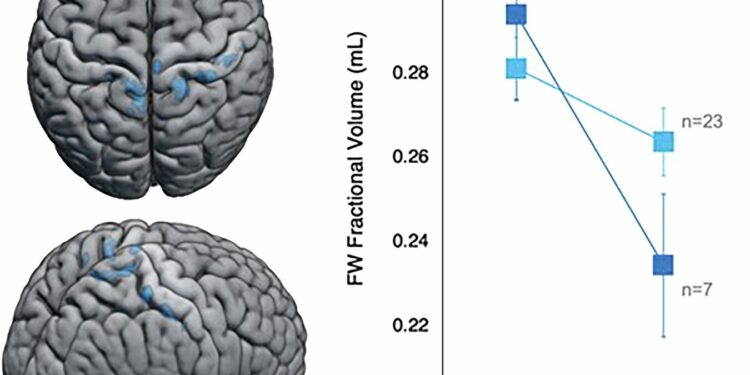Sex differences in free water volume (FW) change after flight. Rendered brains on the left show groups for which male and female crew members exhibited differential changes in FW volume before and after flight. The right graph shows the average FW volume in all significant groups for male (light blue markers) and female (dark blue markers) crew members before and after the flight. Subgroup sample sizes are shown in gray. Error bars represent standard error. The results are family errors corrected to p < 0.05, two-sided. R indicates the right hemisphere. Credit: npj Microgravity(2025). DOI: 10.1038/s41526-025-00505-9
A new study on the impact of spaceflight on the human brain and eyes has found notable gender differences in brain fluid changes, with female astronauts experiencing a greater reduction in fluid around the upper part of the brain than their male counterparts.
Led by Rachael D. Seidler, Ph.D., director of the Astraeus Space Institute at the University of Florida and professor of applied physiology and kinesiology, the study analyzed astronaut data to determine how factors such as gender, age and body parameters relate to structural changes in the brain and eyes after space travel.
The results, published in npj Microgravity provide key information to protect the health of astronauts during long-duration missions to the Moon and Mars.
This is one of the first studies to examine gender differences in the physiological response to spaceflight.
“Data on gender differences in response to spaceflight are scarce, given the historically low number of female astronauts,” Seidler said. “Our dataset still only included about a quarter of women, but because the overall dataset was quite large, we were able to look at gender differences.”
In addition to changes in the fluid around the brain, the team also found that a form of eye compression, characteristic of spaceflight-associated neuro-ocular syndrome known as globe flattening, was the most consistent eye change among crew members.
“By far the most common sign of ocular changes we observed was flattening of the globe, suggesting that this should be the primary target for eye health surveillance,” Seidler said. “Interestingly, eye changes were more common in men than women.”
Globe flattening, when the back of the eyeball becomes slightly indented or pushed inward, may seem minor, but it can have significant effects on vision and cause concern during long-duration space missions.
Surprisingly, there was no strong connection between structural changes in the brain and ocular changes, suggesting that the effects on the eyes and brain may arise from distinct mechanisms rather than common physiological causes.
The research highlights UF’s growing leadership in space health sciences. Through the Astraeus Space Institute, Seidler leads multidisciplinary collaborations that connect neuroscience, physiology and space research to advance human performance and spaceflight safety.
“We used UF’s HiPerGator computing cluster for our analyzes in this study, which allows us to analyze our data at high speed,” Seidler said.
More information:
Heather R. McGregor et al, Crew demographic factors and their association with brain and eye changes following spaceflight, npj Microgravity(2025). DOI: 10.1038/s41526-025-00505-9
Provided by University of Florida
Quote: Spaceflight study finds men experience greater eye changes, while brain differences between sexes are subtle (October 29, 2025) retrieved October 30, 2025 from
This document is subject to copyright. Except for fair use for private study or research purposes, no part may be reproduced without written permission. The content is provided for informational purposes only.



